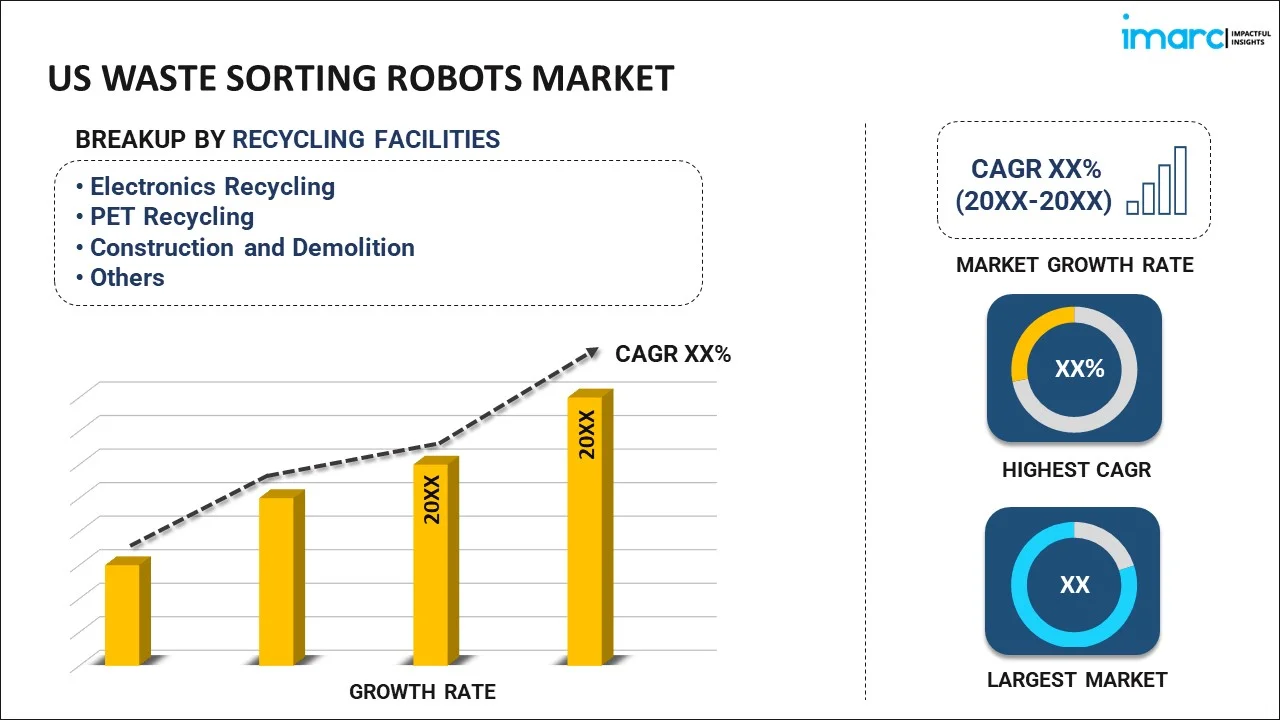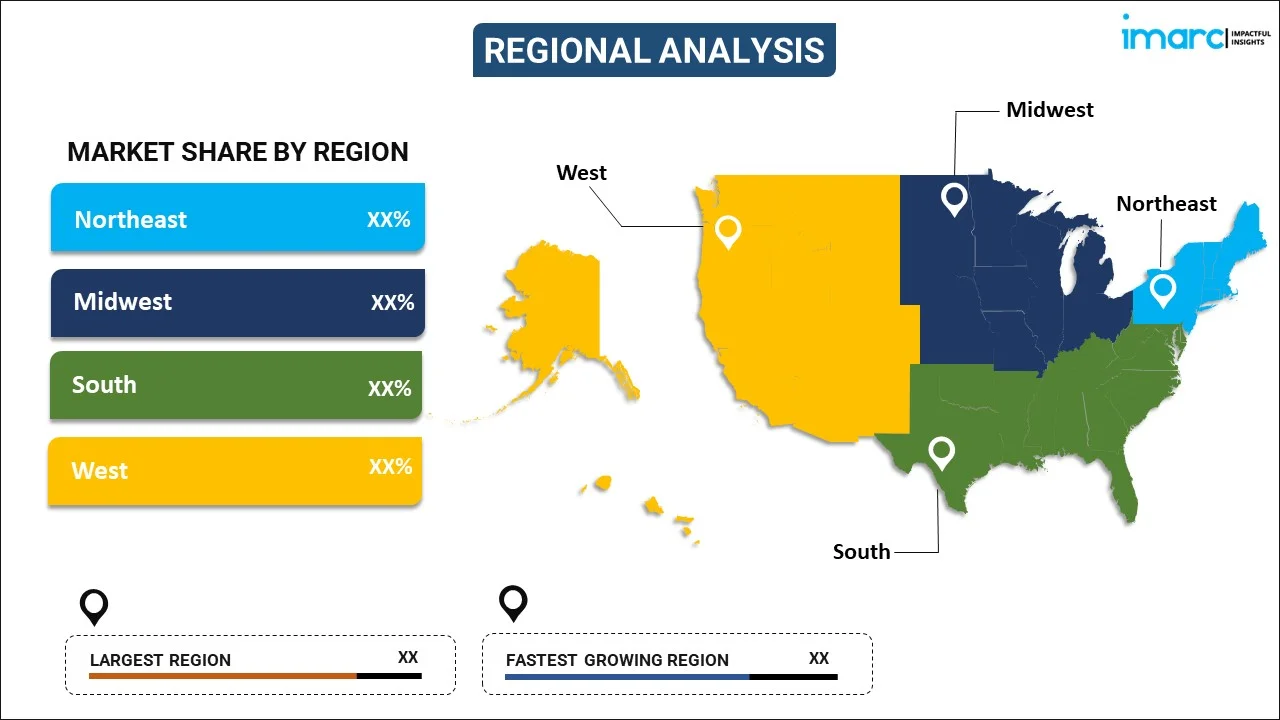
US Waste Sorting Robots Market Report by Recycling Facility (Electronics Recycling, PET Recycling, Construction and Demolition, Mixed Waste, and Others), End User (Municipality, Industrial), and Region 2025-2033
Market Overview:
The US waste sorting robots market size reached USD 824.9 Million in 2024. Looking forward, IMARC Group expects the market to reach USD 3,659 Million by 2033, exhibiting a growth rate (CAGR) of 18.00% during 2025-2033. The rising demand for automation efficiency and accuracy, increasing focus on sustainability, and escalating labor shortage and recycling targets represent some of the key factors driving the market.
|
Report Attribute
|
Key Statistics
|
|---|---|
|
Base Year
|
2024 |
|
Forecast Years
|
2025-2033 |
|
Historical Years
|
2019-2024
|
| Market Size in 2024 | USD 824.9 Million |
| Market Forecast in 2033 | USD 3,659 Million |
| Market Growth Rate (2025-2033) | 18.00% |
Waste sorting robots are advanced technological solutions designed to revolutionize the process of waste management and recycling. They rely on cutting-edge sensors, artificial intelligence (AI), computer vision, and machine learning (ML) algorithms to accurately identify, sort, and segregate different types of waste materials in an automated manner. They are equipped with cameras and sensors that aid in scanning incoming waste streams, distinguishing between various materials, such as plastics, metals, paper, and organic waste. The AI algorithms interpret the collected data, enabling the robots to make real-time decisions on how to effectively sort the waste items. This high level of automation enhances sorting accuracy, increases recycling efficiency, and reduces human error. The implementation of waste sorting robots addresses several challenges faced by the waste management industry, including the need for improved recycling rates, labor shortages, and the growing complexity of waste streams. By optimizing the sorting process, these robots contribute to minimizing the environmental impact of waste, conserving resources, and promoting a circular economy. Their ability to work around the clock, handle repetitive tasks, and adapt to different waste compositions has accelerated their adoption as game-changers in the quest for more sustainable and efficient waste management practices. As a result, waste sorting robots find applications in waste management facilities, recycling centers, and sorting plants across the United States.
US Waste Sorting Robots Market Trends:
The escalating demand for efficient recycling processes owing to the increasing environmental concerns and stringent regulations represents the primary factor driving the market growth. Waste sorting robots, equipped with AI and advanced sensors, offer a highly automated solution to tackle the complexities of waste streams, ensuring accurate identification and separation of recyclable materials. Apart from this, the rising challenge of labor shortages in the waste management sector has accelerated the adoption of these robots as they reduce the dependency on manual sorting, thereby positively influencing market growth. Moreover, the growing awareness about the robots' ability to enhance recycling rates and reduce contamination, which aligns with the increasing sustainability goals of corporations and municipalities, has catalyzed market expansion. Besides this, numerous technological advancements due to heightening investments in research and development (R&D) as stakeholders recognize the economic and environmental benefits of waste sorting robots are another major growth-inducing factor. Additionally, the escalating waste volumes and limited landfill space propel the adoption of waste sorting robots in the US. Furthermore, the rising consumer awareness about recycling and sustainability has augmented the demand for advanced waste sorting solutions. Other factors, including the implementation of stringent regulations on waste disposal and recycling quality, the integration of automation by waste management companies, and increasing interest from investors and venture capital firms in the green technology sector, are also anticipated to provide a positive thrust to the market growth.
US Waste Sorting Robots Market Segmentation:
IMARC Group provides an analysis of the key trends in each segment of the US waste sorting robots market report, along with forecasts at the country level for 2025-2033. Our report has categorized the market based on recycling facilities and end user.
Recycling Facilities Insights:

- Electronics Recycling
- PET Recycling
- Construction and Demolition
- Mixed Waste
- Others
The report has provided a detailed breakup and analysis of the market based on the recycling facilities. This includes electronic recycling, PET recycling, construction and demolition, mixed waste, and others.
End User Insights:
- Municipality
- Industrial
A detailed breakup and analysis of the market based on the end user has also been provided in the report. This includes municipality and industrial.
Regional Insights:

- Northeast
- Midwest
- South
- West
The report has also provided a comprehensive analysis of all the major regional markets, which include Northeast, Midwest, South, and West.
Competitive Landscape:
The report has also provided a comprehensive analysis of the competitive landscape in the market. Competitive analysis such as market structure, key player positioning, top winning strategies, competitive dashboard, and company evaluation quadrant has been covered in the report. Also, detailed profiles of all major companies have been provided.
US Waste Sorting Robots Market Report Coverage:
| Report Features | Details |
|---|---|
| Base Year of the Analysis | 2024 |
| Historical Period | 2019-2024 |
| Forecast Period | 2025-2033 |
| Units | Million USD |
| Scope of the Report | Exploration of Historical and Forecast Trends, Industry Catalysts and Challenges, Segment-Wise Historical and Predictive Market Assessment:
|
| Recycling Facilities Covered | Electronics Recycling, PET Recycling, Construction and Demolition, Mixed Waste, Others |
| End Users Covered | Municipality, Industrial |
| Regions Covered | Northeast, Midwest, South, West |
| Customization Scope | 10% Free Customization |
| Post-Sale Analyst Support | 10-12 Weeks |
| Delivery Format | PDF and Excel through Email (We can also provide the editable version of the report in PPT/Word format on special request) |
Key Questions Answered in This Report:
- How has the US waste sorting robots market performed so far and how will it perform in the coming years?
- What has been the impact of COVID-19 on the US waste sorting robots market?
- What is the breakup of the US waste sorting robots market on the basis of the recycling facilities?
- What is the breakup of the US waste sorting robots market on the basis of the end user?
- What are the various stages in the value chain of the US waste sorting robots market?
- What are the key driving factors and challenges in the US waste sorting robots market?
- What is the structure of the US waste sorting robots market and who are the key players?
- What is the degree of competition in the US waste sorting robots market?
Key Benefits for Stakeholders:
- IMARC’s report offers a comprehensive quantitative analysis of various market segments, historical and current market trends, market forecasts, and dynamics of the US waste sorting robots market from 2019-2033.
- The research study provides the latest information on the market drivers, challenges, and opportunities in the US waste sorting robots market.
- Porter's five forces analysis assist stakeholders in assessing the impact of new entrants, competitive rivalry, supplier power, buyer power, and the threat of substitution. It helps stakeholders to analyze the level of competition within the US waste sorting robots industry and its attractiveness.
- Competitive landscape allows stakeholders to understand their competitive environment and provides an insight into the current positions of key players in the market.
Need more help?
- Speak to our experienced analysts for insights on the current market scenarios.
- Include additional segments and countries to customize the report as per your requirement.
- Gain an unparalleled competitive advantage in your domain by understanding how to utilize the report and positively impacting your operations and revenue.
- For further assistance, please connect with our analysts.
 Inquire Before Buying
Inquire Before Buying
 Speak to an Analyst
Speak to an Analyst
 Request Brochure
Request Brochure
 Request Customization
Request Customization




.webp)




.webp)












